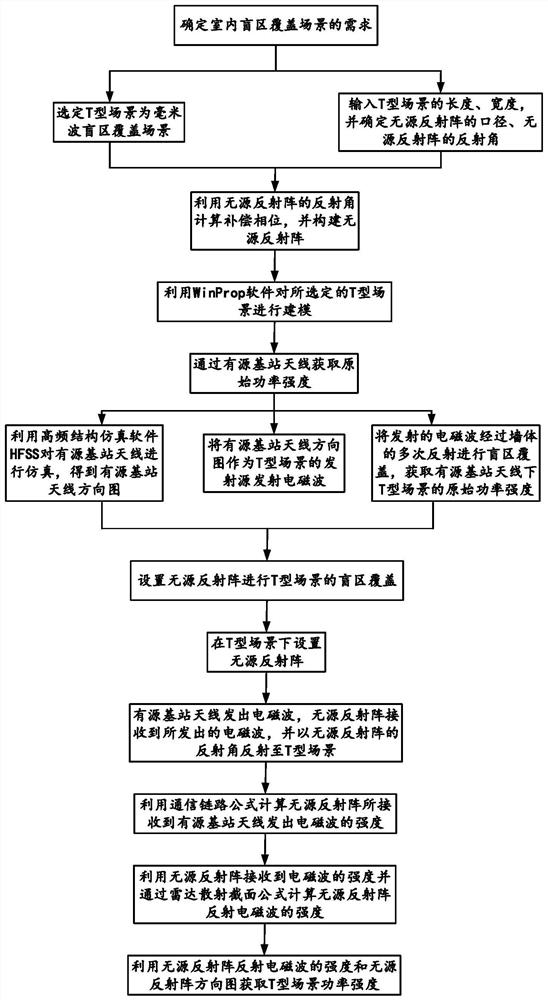A millimeter wave indoor passive coverage method
A millimeter wave and electromagnetic wave technology, applied in wireless communication, electrical components, network planning, etc., can solve the problems of limited application scenarios of reflectors, complex composition structures, poor antenna fusion, etc., to overcome poor antenna fusion, Overcoming the high cost of the antenna and improving the effect of the antenna gain
- Summary
- Abstract
- Description
- Claims
- Application Information
AI Technical Summary
Problems solved by technology
Method used
Image
Examples
Embodiment 1
[0047] refer to figure 1 , figure 2 and image 3
[0048] Step 1. Determine the requirements of indoor blind zone coverage scenarios;
[0049] (1a), the T-shaped scene is selected as the millimeter wave blind zone coverage scene;
[0050] (2b), input the length and width of the T-shaped scene, and determine the aperture of the passive reflector array, the reflection angle 3 of the passive reflector array;
[0051] Step 2, using the reflection angle 3 of the passive reflective array to calculate the compensation phase, and constructing the passive reflective array 1;
[0052] Step 3, utilize WinProp software to model the selected T-shaped scene;
[0053] (3a), from the selected T-shaped scene, obtain the structural dimensions of the wall, door, window, ceiling and floor;
[0054] (3b), respectively carry out modeling to the material of determined wall, door, window, ceiling and floor, and obtain T-shaped scene;
[0055] Step 4, obtain the original power intensity throug...
Embodiment 2
[0087] The diameter of the passive reflector array 1 is 240mm long and 240mm wide.
[0088] The reflection angle 3 of the passive reflection array 1 is 40°-60°. The reflection angle in the present invention is 40°, which can also meet the blind spot coverage requirement.
[0089] The variation range of the compensation phase is >360°.
[0090] The frequency range of the active base station antenna 2 is 24GHz-30GHz, and the half-power lobe width of the pattern of the active base station antenna 2 is ≥20°. The operating frequency in the present invention is 24GHz, and the half-power lobe width is 40°.
[0091] The projection of the center of the active base station antenna 2 to the center of the XOY plane of the passive reflector array coincides with each other.
[0092] Said power intensity ≥ -90dBm.
Embodiment 3
[0094] The diameter of the passive reflector array 1 is 240mm long and 240mm wide.
[0095] The reflection angle 3 of the passive reflection array 1 is 40°-60°. The reflection angle in the present invention is 60°, which can also meet the blind spot coverage requirement.
[0096] The variation range of the compensation phase is >360°.
[0097] The frequency range of the active base station antenna 2 is 24GHz-30GHz, and the half-power lobe width of the pattern of the active base station antenna 2 is ≥20°. The operating frequency in the present invention is 30 GHz, and the half-power lobe width is 40°.
[0098] The projection of the center of the active base station antenna 2 to the center of the XOY plane of the passive reflector array coincides with each other.
[0099] Said power intensity ≥ -90dBm.
[0100] Below in conjunction with accompanying drawing, the simulation result of the present invention is described in further detail
[0101] refer to Figure 4 , Figure...
PUM
 Login to View More
Login to View More Abstract
Description
Claims
Application Information
 Login to View More
Login to View More - R&D
- Intellectual Property
- Life Sciences
- Materials
- Tech Scout
- Unparalleled Data Quality
- Higher Quality Content
- 60% Fewer Hallucinations
Browse by: Latest US Patents, China's latest patents, Technical Efficacy Thesaurus, Application Domain, Technology Topic, Popular Technical Reports.
© 2025 PatSnap. All rights reserved.Legal|Privacy policy|Modern Slavery Act Transparency Statement|Sitemap|About US| Contact US: help@patsnap.com



